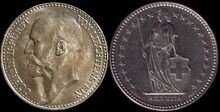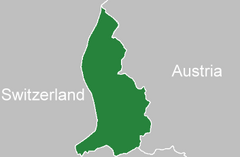| Principality of Liechtenstein Fürstentum Liechtenstein | |||||
|---|---|---|---|---|---|
| |||||
| Capital | |||||
| Languages | |||||
| Demonym |
Liechtensteiner (M) | ||||
| Currency | |||||
| Establishment | |||||
|
1806 | |||||
|
-Independence |
1866 | ||||
| GDP (PPP) | |||||
| -Total |
$3.409 billion (2009) | ||||
| -Per capita |
$95,249 (2009) | ||||
| GDP (nominal) | |||||
| -Total |
$4.797 billion (2009) | ||||
| -Per capita |
$134,045 (2009) | ||||
| v · d · e | |||||
Liechtenstein, officially known as the Principality of Liechtenstein (German: Fürstentum Liechtenstein) is a landlocked alpine country located in Central Europe. It is bordered by Switzerland to the west and south, and Austria to the east.[1]
Etymology[]
The country's name is derived from the German words Licht ("light") and Stein ("stone"), after the name of the ruling dynasty.[2]
History[]

Emperor Charles VI
At one point, the territory was part of the Roman province of Raetia. Subsequently, the province was incorporated into the Frankish Kingdom during the Carolingian reign. In 1342, the county of Vaduz was formed as a subdivision of the Werdenberg county of Montfort of Vorarlberg. Throughout the centuries, the House of Liechtenstein acquired huge landed estates, mostly in Moravia, Lower Austria, and Styria, but all of these rich territories were controlled by more senior feudal lords, particularly under various lines of the Habsburg family. Thus, without holding land directly under the Holy Roman Emperors, the Liechtenstein dynasty was unable to meet the main requirements to qualify for the Reichstag.
In 1699, Prince Hans-Adam I purchased the domain of Schellenberg, and then Vaduz in 1712. By acquiring these lordships, the territory took the name of the family that now ruled it, the Liechtensteins. On January 23, 1719, Emperor Charles VI decreed that the counties of Vaduz and Schellenburg be promoted to a principality with the name "Liechtenstein" for his servant Anton Florian whereby they became Heiliger Römischer Reichsfürst.
In 1806, following the dissolution of the Holy Roman Empire, Liechtenstein became a sovereign state while joining Napoleon's Confederation of the Rhine. The French under Napoleon occupied the country for years, but Liechtenstein retained its independence in 1815. Soon afterward, the country joined the German Confederation. In 1818, Prince Johann I granted the territory a limited constitution, and in 1862, a new constitution was promulgated. After the dissolution of the German Empire, Liechtenstein's army of 80 men was disbanded and the country declared its permanent neutrality, which was respected during World Wars I and II.[3]
Economy[]

|
This page uses Creative Commons Licensed content from Wikipedia (view authors). |
- Main article: Economy of Liechtenstein

The LGT Bank in Vaduz.
Despite having limited natural resources, Liechtenstein is only one of a handful of countries in the world with more registered companies than citizens. It has developed a prosperous, highly industrialized free-enterprise economy and possesses a financial service sector as well as a living standard which compares with those of the urban areas of Liechtenstein's European neighbors.
Within the country, there are very low business taxes (lowest in Europe, with the maximum rate at 20%). This and easy Rules of Incorporation have caused about 73,700 holding companies to build registered offices in Liechtenstein, providing about 30% of the country's state revenue. Revenue is also generated from Stiftungen ("foundations"), which are financial entities created to increase the privacy of nonresident foreigners' financial holdings. The Stiftungen are registered in the name of a citizen of Liechtenstein, often a lawyer.
Recently, Liechtenstein has shown a strong determination in the prosecution of international money-launderers and has worked to promote the country's image as a legitimate finance sector. In February 2008, Liechtenstein's LGT Bank was involved in a German tax-fraud scandal, which strained relations between the two countries. Regent Alois has accused the German government of trafficking stolen goods into Liechtenstein. This refers to its $7.3 million purchase of private banking information illegally offered by a former employee of the LGT Bank. However, the United States Senate's subcommittee on tax haven banks said that the LGT Bank, which is owned by the royal family, "is a willing partner, and an aider and abettor to clients trying to evade taxes, dodge creditors or defy court orders."
Liechtenstein is currently in a customs union with Switzerland, and uses the Swiss franc as a medium of exchange. During May 1995, the country became a member of the European Economic Area (EEA). The Liechtensteiner government is currently working towards harmonizing its economic policies with those of all of Europe. Since 2002, Liechtenstein's unemployment rate has doubled (1.5% in 2008). The gross domestic product (GDP) on a purchasing power parity basis is $5.028 billion, or $141,100 per person.
Liechtenstein is the world's largest producer of sausage casings, potassium storage units, and false teeth. Other industries include electronics, textiles, precision instruments, metal manufacturing; power tools, anchor bolts, calculators, and pharmaceuticals. The country also produces non-industrial products, such as barley, corn, potatoes, wheat, dairy products, livestock, and wine. Tourism also accounts for a large portion of the country's economy.[1]
Taxation[]

Klaus Tschütscher explaining the 2008 tax affair during March 2009.
The Liechtensteiner government taxes both personal and business income and principal. The basic rate of personal income tax is 1.2%. The combined income tax rate is 17.82% when combined with the additional income tax imposed by communes. Another income tax of 4.3% is levied on all employees under the nation's social security program. This rate is typically higher for the self-employed, up to a maximum of 11%. As a result, the maximum income tax rate is about 29%. The basic wealth tax annually, and the combined total rate is 0.89%. The maximum business income tax rate is between 18 and 20 percent.
Gift and estate taxes in Liechtenstein are dependent on the recipient's relationship to the giver and the amount of inheritance. The tax ranges between 0.5% and 0.75% for spouses and children and 18% to 27% for non-related recipients.
The 2008 Liechtenstein tax affair is a series of tax investigations in numerous countries whose governments suspect that some of their citizens may have evaded tax obligations by using banks and trusts in Liechtenstein. The affair began with the largest complex of tax evasion investigations by Germany. It was also seen as an attempt to put pressure on Liechtenstein, which at the time was one of the uncooperative tax havens, along with the microstates of Andorra and Monaco, as defined by the Organization for Economic Cooperation and Development in 2007. Liechtenstein was removed from the blacklist of uncooperative countries by the OECD on May 27, 2009.
The British Government Department, HM Revenue & Customs, agreed with Liechtenstein to start exchanging information in 2009. Currently, it is believed that there are up to 5,000 British investors that have roughly £3 billion stashed in accounts and trusts in the country.[1]
Numismatics[]

A Liechtenstein krone and a Swiss franc coin.
As part of the Roman Province of Raetia, the area of modern-day Liechtenstein used the imperial coinage that was standard throughout the Roman Empire. Following Liechtenstein's annexation to the Frankish Kingdom and later the Kingdom of the East Franks, imperial coins of the territories began to circulate in the area. Upon the area's annexation to the Holy Roman Empire, Liechtenstein adopted the empire's many currencies, which were eventually replaced in the principality by the gulden of the Austrian and Austro-Hungarian Empires. Liechtenstein also issued its coinage from 1728 to 1868. The principality briefly used the South German gulden from 1857 to 1867, but then switched back to the Austro-Hungarian gulden, which was used until 1892. Following the gulden's demise, Austria-Hungary introduced a new currency, the krone, which became widely used in Liechtenstein and the Austro-Hungarian Empire. In 1898, the principality introduced its own krone currency, which circulated alongside the Austro-Hungarian krone in Liechtenstein. In 1921, due to the krone's instability, Liechtenstein entered a customs union with Switzerland, officially adopting the Swiss franc as its currency. The union also granted Liechtenstein the right to produce its own coinage. This right has been exercised by the principality, which issues commemorative frank coins on special occasions. These coins are only legal tender within Liechtenstein.
| Code | Currency Name | Dates | Conversion | Divisions | |||
|---|---|---|---|---|---|---|---|
| Austro-Hungarian gulden |
|
240 Pfennig = 60 Kreuzer = 1 Gulden = 2/3 Thaler | |||||
| South German gulden |
|
240 Pfennig = 60 Kreuzer = 1 Gulden = 2/3 Thaler | |||||
| Austro-Hungarian gulden |
|
240 Pfennig = 60 Kreuzer = 1 Gulden = 2/3 Thaler | |||||
| Austro-Hungarian krone |
|
1 Gulden = 2 Kronen | 100 Heller/Fillér = 1 Krone | ||||
| Liechtenstein krone |
|
100 Heller = 1 Krone | |||||
| CHF | Swiss franc |
|
100 Centimes = 1 Franc | ||||
| Liechtenstein frank |
|
100 Centimes = 1 Frank |
References[]
| Currency Wiki has 7 images related to Liechtenstein. |
| Europe | |
|---|---|
| Countries | Albania • Andorra • Armenia* • Austria • Azerbaijan* • Belarus • Belgium • Bosnia and Herzegovina • Bulgaria • Croatia • Cyprus* • Czech Republic • Denmark • Estonia • Finland • France • Georgia* • Germany • Greece • Hungary • Iceland • Ireland • Italy • Kazakhstan* • Latvia • Liechtenstein • Lithuania • Luxembourg • Macedonia • Malta • Moldova • Monaco • Montenegro • Netherlands • Norway • Poland • Portugal • Romania • Russia* • San Marino • Serbia • Slovakia • Slovenia • Spain • Sweden • Switzerland • Turkey* • Ukraine • United Kingdom • Vatican City |
| De facto countries | Abkhazia* • Kosovo • Nagorno-Karabakh* • Northern Cyprus* • South Ossetia* • Transnistria |
| Dependencies | Åland • Faroe Islands • Gibraltar • Guernsey • Isle of Man • Jersey • Republika Srpska • Svalbard and Jan Mayen |




